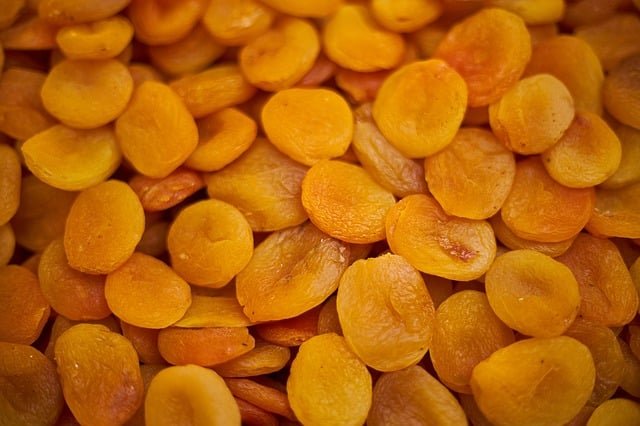Are you always looking for a wholesome snack that is high in antioxidants? Dehydrating apricots are a perfect choice! It takes just a few hours to dehydrate apricots, and they can be stored at room temperature until you’re ready to eat them. Apricot dehydrated fruit makes an excellent addition to yogurt parfaits, granola bars, or salads.
What Do I Need?
- A food dehydrator ( I like using the Excalibur 9 trays dehydrator)
- Apricots ( I like using organic dried apricots from Trader Joe’s because they are soft and easy to dehydrate without additional preparation, but any fruit will work.)
- A large bowl.
- A dehydrator sheet (optional)
- Sharp knife for cutting apricots into slices and a mandoline slicer or other method to slice the dehydrated apricot pieces.
Ingredients
- A bunch of apricots.
- One cup of lemon juice.
- Four cups of water.
How to Find the Best Apricots for Dehydrating
Buy or pick your apricots when they are fully ripe and still a little hard; this is when they have the most flavor and are not too mushy to dehydrate successfully.
Look for plump apricots, well colored with an even skin color all over.
Choose ones without large cracks or spots of mold on their surface, indicating decay inside the fruit.
Look for sales when you are looking for fresh apricots so that you can save money.
Consider going to a local farmer’s market, fruit stand, or grocery store.
If this is not possible, purchase from your supermarket’s produce department when they have good sales on fresh fruits like avocados and peaches, which would make for an excellent dehydrating project.
How to Dehydrate Apricots
Apricots dehydrate very quickly and can be eaten or reconstituted in water to make a delicious, healthy snack. Dehydrating apricot is easy enough for children to do with supervision from an adult.
Let’s get started dehydrating apricots.
- First, to dehydrate the apricot, gather all of your ingredients and utensils in advance, so you don’t forget anything or have to stop midway through preparation.
- Wash the apricots thoroughly before dehydrating them so that they will not get moldy.
- Dehydrating apricots is easy and fast. First, you slice them in half, remove the seeds.
- In a large bowl, combine water and lemon juice. Add the sliced apricots.
- Remove from bowl and dry gently any water droplets or juice.
- Put the apricots on dehydrating sheets and gently push them in a dehydrator so they’re flat on your Excalibur drying tray with their skin side down and flesh facing upwards.
- -Set at 135 degrees Fahrenheit for 18 to 24 hours so they will dehydrate evenly. Make sure to read the manufacturer’s manual for the appropriate drying times. Also, make sure to monitor your food.
- – After dehydrating is complete, store the dried apricots in airtight containers or plastic bags so that they will stay fresh longer. They can also be dehydrated for less time so that they are crispy and eaten as a snack.
How to Tell If My Apricots Have Been Dehydrated?
The apricots should be slightly soft but leathery when they are done if dehydrated apricots are dry to the touch with no moisture left on the surface.
Health Benefits of Apricots
Apricots are a delicious and healthy snack. These little fruits have many health benefits, including:
Apricots have antioxidants properties that can help fight free radicals in the body and are also a great source of vitamin A. Vitamin A is essential in maintaining healthy skin, teeth, and eyesight.
Another benefit of the apricot is that it helps reduce the risk of heart disease by lowering cholesterol levels.
They are a perfect dehydrating apricot snack!
Uses of The Dehydrated Apricots
Apricots dehydrated make a great snack. They are perfect for school lunch boxes, work bags, and as an after-school treat or dessert. In addition, you can add them to yogurt, cereal, oatmeal, and your favorite gluten-free bread!
They are also great for dehydrating fruit leathers, trail mix, and desserts like apricot bars, pie crusts, and cookies!
They also make healthy additions to smoothies and other fruit drinks like lemonade or iced tea.
The dehydrated apricot is also a perfect emergency food. They are ready in minutes and have extraordinarily long shelf lives.
Recipes for Using Dried Apricots
- Dried Apricot Jam
- Apricot Tart
- Apricot and Nut Cookies
- Trail Mix
- Apricot and Cheese
- And many more!
Benefits of Eating Dried Fruit
Dried fruit is an excellent source of antioxidants and fiber. It has been shown to improve blood flow, digestive health, reduce oxidative damage in the body, and lower one’s risk for diseases such as cancer or diabetes. The antioxidant polyphenols found within dried fruit are responsible for these effects!
Nutrition Facts about Dried Apricots
According to Food Data Central, just two fresh apricots (70 grams) provide:
- Calories: 34
- Carbs: 8 grams
- Protein: 1 gram
- Fat: 0.27 grams
- Fiber: 1.5 grams
- Vitamin A: 8% of the Daily Value (DV)
- Vitamin C: 8% of the DV
- Vitamin E: 4% of the DV
- Potassium: 4% of the DV
Apricots are a delicious, nutritious fruit that is best enjoyed in their natural form. The skin contains large amounts of fiber and nutrients, so discard the stone; it’s not edible!
Conclusion
If you’re looking for a great way to save money on your grocery bill, it’s time to start dehydrating fruits and vegetables. This is an easy process that will give you a plethora of healthy snacks throughout the week and provide you with some much-needed savings in your budget! So give this simple recipe from our blog post a try today, and soon enough, apricots will be all dried out.

